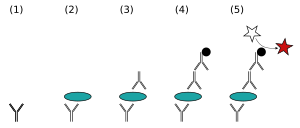| Revision as of 01:54, 15 March 2007 edit24.13.200.97 (talk) →Methods← Previous edit | Revision as of 01:55, 15 March 2007 edit undo24.13.200.97 (talk) →MethodsNext edit → | ||
| Line 43: | Line 43: | ||
| For competitive ELISA, the higher the original antigen concentration, the weaker the eventual signal. | For competitive ELISA, the higher the original antigen concentration, the weaker the eventual signal. | ||
| i love south park | |||
| boo | |||
| ==See also== | ==See also== | ||
Revision as of 01:55, 15 March 2007
The Enzyme-Linked ImmunoSorbent Assay, or ELISA, is a biochemical technique used mainly in immunology to detect the presence of an antibody or an antigen in a sample. It uses two antibodies. One antibody is specific to the antigen. The other reacts to antigen-antibody complexes, and is coupled to an enzyme. This second antibody, which accounts for "enzyme-linked" in the test's name, can also cause a chromogenic or fluorogenic substrate to produce a signal. Because the ELISA can be performed to evaluate either the presence of antigen or the presence of antibody in a sample, it is a useful tool both for determining serum antibody concentrations (such as with the Human Immunodeficiency Virus, HIV test or West Nile Virus) and also for detecting the presence of antigen. It has also found applications in the food industry in detecting potential food allergens such as milk, peanuts, walnuts, almonds, and eggs.
Methods
The steps of the general, "indirect," ELISA for determining serum antibody concentrations are:
- Apply a sample of known antigen to a surface, often the well of a microtiter plate. The antigen is fixed to the surface to render it immobile.
- The plate wells or other surface are then coated with serum samples of unknown antibody concentration, usually diluted in another species' serum. The use of non-human serum prevents non-specific antibodies in the patient's blood from binding to the antigen.
- The plate is washed, so that unbound antibody is removed. After this wash, only the antibody-antigen complexes remain attached to the well.
- The second antibodies, which will bind to any antigen-antibody complexes, are added to the wells. These second antibodies are coupled to the substrate-modifying enzyme.
- Wash the plate, so that excess unbound antibodies are removed.
- Apply a substrate which is converted by the enzyme to elicit a chromogenic or fluorescent signal.
- View/quantify the result using a spectrophotometer or other optical device.
The enzyme acts as an amplifier; even if only few enzyme-linked antibodies remain bound, the enzyme molecules will produce many signal molecules.
ELISA may be run in a qualitative or quantitative format. Qualitative results provide a simple positive or negative result for a sample. The cutoff between positive and negative is determined by the analyst and may be statistical. Two or three times the standard deviation is often used to distinguish positive and negative samples. In quantitative ELISA, the optical density or fluorescent units of the sample is interpolated into a standard curve, which is typically a serial dilution of the target.
Sandwich ELISA

A less-common variant of this technique, called "sandwich" ELISA, is used to detect sample antigen. The steps are as follows:
- Prepare a surface to which a known quantity of antibody is bound.
- Apply the antigen-containing sample to the plate.
- Wash the plate, so that unbound antigen is removed.
- Apply the enzyme-linked antibodies which are also specific to the antigen.
- Wash the plate, so that the unbound antibodies are removed.
- Apply a chemical which is converted by the enzyme into a fluorescent signal.
- View the result: if it fluoresces, then the sample contained antigen.
The image to the right, includes an additional step, the addition of 'detecting antibody', used to avoid the expensive conjugation process that would be necessary to create enzyme-linked antibodies for every antigen one might want to detect. By using an enzyme-linked antibody that binds the Fc region of other antibodies, this same enzyme-linked antibody can be used in a variety of situations.
Competitive ELISA
A third use of ELISA is through competitive binding. The steps for this ELISA are somewhat different than the first two examples:
- Unlabeled antibody is incubated in the presence of its antigen.
- These bound antibody/antigen complexes are then added to an antigen coated well.
- The plate is washed, so that unbound antibody is removed. (The more antigen in the sample, the less antibody will be able to bind to the antigen in the well, hence "competition.")
- The secondary antibody, specific to the primary antibody is added. This second antibody is coupled to the enzyme.
- A substrate is added, and remaining enzymes elicit a chromogenic or fluorescent signal.
For competitive ELISA, the higher the original antigen concentration, the weaker the eventual signal. i love south park
See also
External links
- An animated illustration of an ELISA assay
- An animated tutorial comparing the direct and indirect ELISA methods
- Online bookshelf from NCBI: searchable text books in molecular biology and related fields
- "Introduction to ELISA Activity - beginner walkthrough of ELISA used for detecting HIV, including animations
- Image of a plate, such as is commonly used in ELISA tests
- ELISA "The Standard Food Allergy Panel" has been adapted by some labs for use in detecting food allergies, especially for treatment of Irritable Bowel Syndrome (IBS)
References
- Engvall E, Perlman P. "Enzyme-linked immunosorbent assay (ELISA). Quantitative assay of immunoglobulin G", Immunochemistry, 1971 Sep;8(9):871-4 PMID: 5135623
- Goldsby, R.A., Kindt, T.J., Osborne, B.A. & Kuby, J. Enzyme-Linked Immunosorbent Assay. In: Immunology, 5th ed.(2003), pp. 148-150. W. H. Freeman, New York.